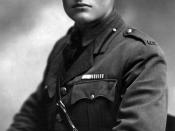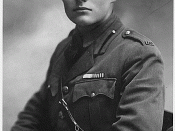Influence of Realism on Literature
After World War I, American people and the authors among them
were left disillusioned by the effects that war had on their society.
America needed a literature that would explain what had happened and
what was happening to their society. American writers turned to what
is now known as modernism. The influence of 19th Century realism and
naturalism and their truthful representation of American life and
people was evident in post World War I modernism. This paper will try
to prove this by presenting the basic ideas and of these literary
genres, literary examples of each, and then make connections between
the two literary movements. Realism Modernism not only depicted
American society after World War I accurately and unbiasedly, but also
tried to find the solutions brought upon by the suffering created by
the war (Elliott 705).
The realistic movement of the late 19th century saw authors
accurately depict life and it's problems.
Realists attempted to "give
a comprehensive picture of modern life" (Elliott 502) by presenting
the entire picture. They did not try to give one view of life but
instead attempted to show the different classes, manners, and
stratification of life in America. Realists created this picture of
America by combining a wide variety of "details derived from
observation and documentation..." to "approach the norm of
experience..." (3). Along with this technique, realists compared the
"objective or absolute existence" in America to that of the "universal
truths, or observed facts of life" (Harvey 12). In other words,
realists objectively looked at American society and pointed out the
aspects that it had in common with the general truths of existence.
This realistic movement evolved as a result of many changes
and transitions in American culture. In the late 1800's, the United
States was experiencing "swift growth and change" as a result of a
changing economy, society, and culture because of an influx in the
number of immigrants into America. Realists such as Henry James and
William Dean Howells, two of the most prolific writers of the
Nineteenth-century, used typical realistic methods to create an
accurate depiction of changing American life. William Dean Howells,
while opposing idealization, made his "comic criticisms of society"
(Bradley 114) by comparing American culture with those of other
countries. In his "comic" writings, Howells criticized American
morality and ethics but still managed to accurately portray life as it
happened. He attacked and attempted to resolve "the moral
difficulties of society by this rapid change." (Elliott 505). He
believed that novels should "should present life as it is, not as it
might be" (American Literature Compton's). In the process of doing
this, Howells demonstrated how life shaped the characters of his
novels and their own motives and inspirations. By concentrating on
these characters' strengths as opposed to a strong plot, he
thematically wrote of how life was more good than evil and, in return,
wanted his literature to inspire more good. On the other hand, Henry
James judged the world from a perspective "...offered by society and
history..." (704). He also separated himself from America to create an
unbiased view of it as a "spectator and analyst rather than recorder"
(Spiller 169) of the American social structure. He wrote from a
perspective that allowed him to contrast American society with that of
Europe by contrasting the peoples' ideas. By contrasting social
values and personal though about America in America, he presented to
the people the differing motivational factors that stimulated the
different social classes (Bradley 1143). Overall, these writers
managed to very formally portray America as it was while adding their
own criticisms about it in an attempt to stimulate change.
The naturalist movement slowly developed with most of the same
ideals as those of the realists in that it attempted to find life's
truths. In contrast, Naturalists, extreme realists, saw the corrupt
side of life and how environment "deprived individuals of
responsibility" (Elliott 514). Literary naturalism invited writers to
examine human beings objectively, as a "scientist studies nature"
("Am. Lit." Compton's). In portraying ugliness and cruelty, the
authors refrained from preaching about them; rather they left readers
to draw their own conclusions about the life they presented.
Generally, these authors took a pessimistic view to portray a life
that centered on the negative part of man's existence. When dealing
with society directly, naturalists generally detailed the destruction
of people without any sentiment. To do this, they wrote more open
about society's problems in a more open manner usually using nature as
a symbol for society. Naturalistic literature, like realistic,
served as a catalyst for change but, in contrast, was a little more
like propaganda.
Even though only twenty years may have separated them, the
transformation from realism/naturalism to modernism was a long one in
terms of how much society had changed. The aforementioned rapid
change in American society and America's relation with the rest of the
world left America in disarray. After the first World War, American
society was divided and left without definition. This called for a
new age of literary expression to control and document the
"isolationist fears", "corruption", and "disenchantment" (Bradley
1339-1340) caused by the war. Authors looked to explain their
generation and to respond to the "social and moral confusions" (1340).
The World War broke down America's fundamental institutions by
dehumanizing the people that provided their strong foundations (1339).
War diminished the individual identity and the society as a whole.
The human personality was "dwarfed" as much by the "...dehumanizing
magnitude of modern events..." as by natural laws that con!
trolled man to their own destiny.
Authors after World War I created a new literature "of
enduring merit...that shattered conventional taboos in their
expression of physical and psychological actuality." (Bradley 1339)
This was the beginning of modernism. Modernism, although strongly
influenced by realism and often referred to as an extension of
naturalistic values, was the answer to America's new-found problems.
Modernism promoted and combined the scientific aspects of naturalism
along with a psychological examination of the individual and the
culture. By being so experimental (1340) and intense(1337), modernism
was able to unite America after a period of crisis. Modernism
centered on "explorations into the spiritual nature of men and the
value of his society and institutions." (1337) Like realism,
modernists focused on changes on society (Elliott 699) and used
symbolism, although in this case spiritual, to draw their fiction
(Bradley 1340). Modernist writers, like most Americans, were amazed
at the destructive power of war on the common man.
Writers such as Ernest Hemingway, William Faulkner, and F.
Scott Fitzgerald spearheaded the modernistic renaissance by employing
realistic and naturalistic techniques. Hemingway's The Sun Also Rises
details the principle of an "alienation from society that had been
forced upon by the circumstances of the time" (Spiller 271). In this
case, it describes a young boy alienated from society because of his
involvement in World War I, the "...loss of faith and hope...", and
"...collapse of former values..." that occurs (Hart 284). His
earlier works can sometimes be described as containing "characteristic
influences of naturalism" (Bradley 1339). This can be reflected in
his "presentation of the strict relations between environment and
fate..." (1339). Later in his career, Hemingway once again took the
alienation from society route. This time, in the spirit of realist
Henry James, he separates himself from American society to better
judge it. With his novel The Rolling Hills of Africa, Hemingway
compares American culture to that of another. At times, Hemingway
"...began to seem like a little more than a modern realist..."
(Spiller Lit His 1300).
William Faulkner, producer of some of the most important books
of the twentieth-century, also draws the connection between
environment and fate strongly. He combines naturalism and
primitivism, a literary technique involving clear imagery, to create a
sometimes confusing and complex detailed reading that involves
"...people of all sorts wealthy and poor, evil and good, slave and
free come into sharp focus in his writing." ("Faulkner" Compton's)
This idea, much like that of realist James, provides the reader with
the whole picture of society.
The novels and short stories of F. Scott Fitzgerald are famous
for portraying the "lost generation" of the post-World War I era.
Faulkner's moral values were "social rather than personal"
("Fitzgerald" Compton's). He believes that his writing should address
the problems that society has and the problems that he has with
society. Faulkner's prose is ornate and complex. His sentences are
long and complicated, and many nouns and adjectives are used.
Hemingway's style is quite the opposite. His sentences are short and
pointed, and adjectives are used sparingly. The effect is one of great
power and compression. By compressing his literary ideas in his
writing, he makes his literature easily understood and direct to his
readers.
Many connections can be made between the literature of the
late 19th century realism and naturalism and that of post-World War I
modernism. First and most importantly of all, modernists, like
realists and naturalists, attacked society's problems by using
symbolism to make their own judgments of the basic foundations of
American life. Modernists, such as Ernest Hemingway, looked at
American society and compared to that of other cultures of the world.
This technique had been extensively employed by such realists as
Henry James. Modernism used the naturalist method of scientifically
exploring the individual and the society. Stylistically, modernists,
with the exception of Hemingway, wrote in a very formal, defined form.
Modernists and realists both attacked the moral dilemmas in society.
The only difference was that these dilemmas were different.
While that realists attempted to "give a comprehensive picture
of modern life..." (502), modernists wished "express the whole
experience of modern life." (Elliott 598). These authors of the
realistic and modernistic period had the same goals so naturally they
wrote using the same ideas, methods, and principles. Realists focused
on different literary aspects to detail how American culture was
effected by these changes. They detailed characters shaped by society
and tried to convey the good and evil aspects of life. Mirroring this
technique, modernists portrayed people alienated and rejected from
society because of the effects of the first World War. Both focused
on detailing problems facing their characters, externally and
internally, while not focusing on plot development. Thematically,
both groups of authors conveyed the good and bad aspects of a
changing American society. Both rallied for change and both asked for
the unification of society, but both still lingered more on the
presence of corruption in America.
The only thing that separated the two movements was the
societies around them. While both societies were experiencing major
change quickly, they were so different. The two literatures had to be
distinguished not because of their content and character, which was
for the most part the same, but instead because of the differing
conditions that existed around the literature. Even though both
wanted to accurately depict life, they were written in two very
distinct times in American history. In one, American culture was
expanding and adapting. In the other, life was being oppressed by the
dehumanizing agents of warfare on a large scale. As we know, culture
influences literature. Even though these two literary movements may
have only been separated by about twenty years, in these twenty years,
focus shifted from the interior of American society to how American
society was effected by a conflict created as a result of opposing
cultures. This idea of differing cultures produc!
ing differing literatures provides the basis for the differences in
the movements.
Modernism after World War I was influenced by the
realistic/naturalistic movement of the late Nineteenth century. The
literary goals, techniques, and principles of the modernists and
realists/naturalists were the same. Both wanted to paint an unbiased,
accurate picture of society by confronting the problems of the
individual and of the society. To do this, most of the time they
resorted to the same techniques. They created literature that
combined scientific reasoning, unidealistic views, and physical and
psychological examination that painted a portrait of society that
could be used to help American society adjust, define, and heal.
Realists of the late Nineteenth century and modernists of the 1920's
wrote alike but were divided on the basis that their respective
societies were so different.
--
Works Cited
"American Literature". Compton's Interactive Encyclopedia (Computer
Program) 1995 Bradley, Sculley. The American Tradition in Literature.
New York City: W.W. Norton and Company, Inc., 1967: 1336-1342
Elliott, Emory. Columbia Literary History of the United States. New
York City:Columbia University Press:1988, 502-504, 599
"Faulkner, William". Compton's Interactive Encyclopedia (Computer
Program) 1995
"Fitzgerald, Scott F.". Compton's Interactive Encyclopedia (Computer
Program) 1995 Hart, James D. The Oxford Companion to American
Literature. New York City:Oxford University Press, 1995: 284-285
Pizer, Donald. Realism and Naturalism. Carbondale: Southern Illinois
University Press, 1966: 3, 10-11
Spiller, Robert E. The Cycle of American Literature. New York City:
The MacMillan Company, 1966: 269-303
Spiller, Robert E. et al. Literary History of the United States. New
York City: The MacMillan Publishing Company, 1974: 1300


